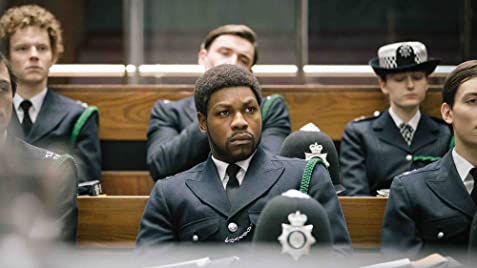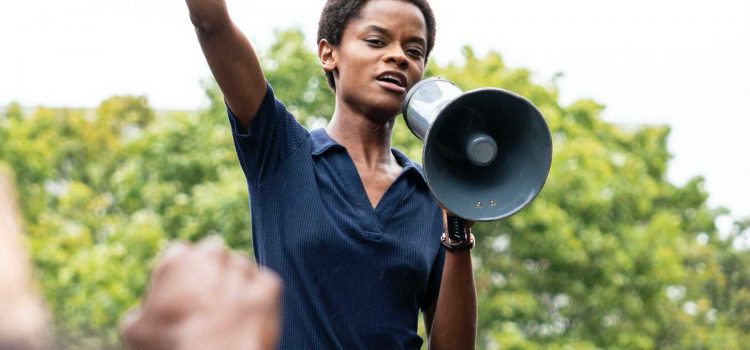By Alex McPherson
Director Steve McQueen’s “Red, White and Blue,” the third installment of “Small Axe,” provides a heartbreaking look at racism within policing, and a thought-provoking, brilliantly acted character study.
“Red, White and Blue” depicts the true story of Leroy Logan (John Boyega), a forensic scientist living in London during the early 1980s with his West Indian family. Yearning to more directly impact the community he resides in, Leroy considers joining the local police force. After his father, Kenneth (Steve Touissant), is beaten by a couple of officers seemingly at random, Leroy’s motivation to become involved heightens, despite Kenneth’s fierce objection.
While Leroy understands the difficulties that this career choice entails, he believes, somewhat idealistically, that he can shift attitudes and mindsets from within it, helping to combat the flaws pervading policing. Although Leroy receives support from his loving wife, Gretl (Antonia Thomas), and family friend Jesse (Nadine Marshall), who works as a liaison for the Met, he soon finds himself ostracized by his own community and encounters challenges that leave him scarred and exhausted, yet ever aware that major systemic change must occur.
Featuring an absolutely incredible lead performance, and a story that viscerally showcases the difficulty of fighting a system much larger than any single person, “Red, White and Blue” is a sobering exploration of injustice and family bonds, providing some of the most powerful moments of the entire “Small Axe” series.
Similar to “Mangrove,” McQueen spends ample time establishing who Leroy is as a person and detailing his relationships with friends and family members, particularly his father. Leroy is an admirable, strong-willed individual with a warm heart and diligent work ethic, who’s determined to make a noticeable impact in the police force. He puts in his all, even outperforming a number of his peers in police training. Boyega is an endearing presence throughout the film, portraying Leroy’s skepticism and self-doubt later on with heartbreaking impact.
Indeed, “Red, White and Blue” grows increasingly grim as it goes on, as Leroy’s own end goals seemingly slip away from him. The film frequently slows down to focus on Boyega’s reactions and Leroy’s self-reflection. As Leroy looks at himself in the mirror, for example, dressed up in uniform, we understand the inner conflict he feels, and appreciate the threats and dangers he faces in this line of work. With only one other person of color on the force with him, Leroy feels adrift and alienated practically wherever he goes, lacking figurative reinforcements to help him achieve his vision.
Although he receives some aforementioned support from family members, Kenneth adamantly opposes Leroy’s decision to become a police officer — believing that Leroy is squandering his education to become involved in an organization pervaded by prejudice, putting his own and his family’s way of life at risk. In fact, this father-son relationship remains the film’s emotional core, providing two valid yet conflicting mentalities that provide much food for thought.
Finding a balance between Leroy and Kenneth’s views is quite challenging — a balance between comfort and risk, between change and maintaining the status quo. McQueen depicts them both as weathered, wise individuals eventually sharing an understanding that they exist in a world where change is often slight and difficult to achieve, yet always worth fighting for, even if it means starting from scratch. As a result, “Red, White and Blue” lacks clear resolution or a sense of catharsis, ending on a note of meditative reflection that resonates with me long after the credits rolled.
Despite the film’s intensity, however, there’s still much to relish in “Red, White and Blue,” just like the other “Small Axe” entries. McQueen’s attention to period detail is on full display, with a soundtrack featuring Al Green songs that infuses the proceedings with added emotional and symbolic weight.
The cinematography by Shabier Kirchner is outstanding, once again, containing numerous shots — especially during an atmospheric, nail-biting sequence where Leroy tracks down a criminal on his own — that have etched themselves into my psyche.
Even though I wish McQueen would have shown more of Leroy’s life story, such as his founding of the Black Police Association, the power of “Red, White and Blue” is undeniable. This is yet another fantastic entry in McQueen’s “Small Axe” series, tragic yet essential viewing. Although little has seemingly changed regarding policing between then and now, the film remains a testament to bravery, heroism, and perseverance to confront social issues that remain sadly relevant today.
“Red, White and Blue” is part of the “Small Axe” anthology, directed by Steve McQueen, that is a part of a TV mini-series on Amazon Prime. The drama’s run time is 1 hour, 20 minutes. Alex’s Rating: A
Alex McPherson is an unabashed pop culture nerd and a member of the St. Louis Film Critics Association.



